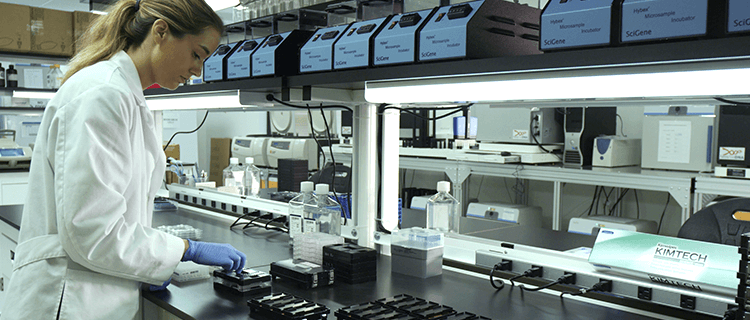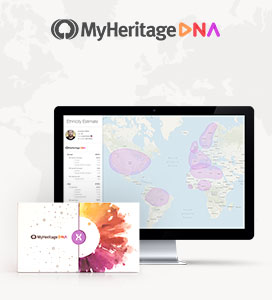DNA Testing

Discover your ancestry with DNA testing — genealogy has never been easier or more reliable
You may have heard about the newest frontier of personal research — DNA testing. Now DNA testing is more accessible than ever before. DNA testing can tell you about your ethnic origins and help you discover family members you never knew existed. Easy-to-use, highly reliable, and affordable, DNA kits are also more available than ever, allowing you to unlock the unique information written in every cell of your body. All it takes is a simple cheek swab; then you sit back and wait, as the best technology science has to offer reveals fascinating new information about you, your family, and your past.
What is DNA testing?
DNA testing takes a sample of your cells — often epithelial cells from inside your cheek — and extracts the DNA from it. The DNA testing process then decodes certain segments called markers, known to contain clues to your genetic past. Since DNA is passed down through the generations and is the blueprint for our traits, we can learn a lot by decoding our DNA and reading the information written there. For example, you might learn which physical features you have inherited from past generations, or even whether your strong dislike of coriander could be genetic.
Every person really is unique, down to the arrangement of molecules that make up our DNA. No two people have the exact same DNA. However, all of the differences in DNA that make people unique exist in about 1% of the code. In other words, all people have about 99% of their DNA in common with everyone else, and only about 1% is different. People who are closely related have similar versions of the variable 1%, since DNA is inherited, and a common source of inheritance (i.e., a common ancestor) results in similar genetic makeup. People who are more distantly related have fewer similar sections within the variable 1%. People who are completely unrelated have very different DNA across all of the variable sections.
Every person really is unique, down to the arrangement of molecules that make up our DNA. No two people have the exact same DNA. However, all of the differences in DNA that make people unique exist in about 1% of the code. In other words, all people have about 99% of their DNA in common with everyone else, and only about 1% is different. People who are closely related have similar versions of the variable 1%, since DNA is inherited, and a common source of inheritance (i.e., a common ancestor) results in similar genetic makeup. People who are more distantly related have fewer similar sections within the variable 1%. People who are completely unrelated have very different DNA across all of the variable sections.
The MyHeritage DNA test
While you may have heard about DNA testing on TV as a way to irrefutably identify criminals, at MyHeritage DNA, we test for very different reasons! With a MyHeritage DNA kit, you can find out your ethnic origins. Want to know where your ancestors came from? The location of your ancestral home? It’s written in your DNA! You might think you already know where your family came from. A lot of families and communities preserve their history orally for many generations. But every now and then, there are surprises! Whether you think you know the whole story or not, DNA testing can often go further back in time than you have written records or even oral histories for.
MyHeritage also offers DNA matches, where we compare your DNA to all of the other DNA test results in our database to determine whether you might have relatives you never knew about. You can compare family trees with your DNA Matches to determine if and how you really are related. Sometimes DNA Matches contact each other directly and are able to help each other expand their family histories extensively.
MyHeritage also offers DNA matches, where we compare your DNA to all of the other DNA test results in our database to determine whether you might have relatives you never knew about. You can compare family trees with your DNA Matches to determine if and how you really are related. Sometimes DNA Matches contact each other directly and are able to help each other expand their family histories extensively.
How does DNA testing enhance family history?
You inherit 50% of your DNA from your mother and 50% from your father. Each of them received 50% of their DNA from their mothers, and 50% from their fathers. So when we look at your DNA, we’re looking at about half of your mom’s and half of your dad’s, which is about 25% of each of your grandparents, or 12.5% of each of your great grandparents. In other words, by looking at your DNA, we can see a little piece of all of the ancestors who together gave you the exact combination of DNA you have today.
It follows, then, that two people who inherited DNA from the same source, have some common DNA between them. For example, a daughter who received 50% of her mother’s DNA and 50% of her father’s DNA, likely shares some DNA with her brother, who also inherited half of his DNA from each parent. By the same token, it is likely that the brother and sister inherit a different 50% of each parent’s DNA, which is why siblings don’t have identical DNA (unless they’re identical twins). Nevertheless,
children born to the same parents have about 50% of their DNA in common.
Genetic testing can reveal not only the amount of DNA two people have in common, and therefore serve as a good indication of their relationship; it can also show exactly which segments they have in common. Comparing family histories with your DNA Matches allows you to explore your family history with new depth, and thereby enhance your understanding of your unique heritage. MyHeritage DNA testing has already changed the lives of millions of people. Will you be next?
It follows, then, that two people who inherited DNA from the same source, have some common DNA between them. For example, a daughter who received 50% of her mother’s DNA and 50% of her father’s DNA, likely shares some DNA with her brother, who also inherited half of his DNA from each parent. By the same token, it is likely that the brother and sister inherit a different 50% of each parent’s DNA, which is why siblings don’t have identical DNA (unless they’re identical twins). Nevertheless,
children born to the same parents have about 50% of their DNA in common.
Genetic testing can reveal not only the amount of DNA two people have in common, and therefore serve as a good indication of their relationship; it can also show exactly which segments they have in common. Comparing family histories with your DNA Matches allows you to explore your family history with new depth, and thereby enhance your understanding of your unique heritage. MyHeritage DNA testing has already changed the lives of millions of people. Will you be next?

